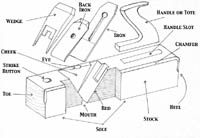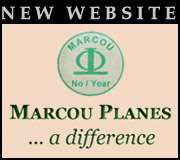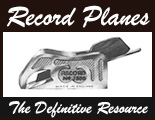Parts Of A Wooden Plane
 While the various names to describe the parts of hand planes may differ slightly from country to country they are, for the most part, standardized. For instance what is known as a “cutter” or “iron” in Britain and Europe is generally called a “blade” in America. Many of the names used come from anatomical names, so you end up with terms such as eyes, ears, cheeks, face, mouth, throat, toes and heels etc. These all come together to form the “body” of the plane. The descriptive terminology used by the planemaker’s themselves, however, was never standardized per sé, but tend to follow the same general pattern.
While the various names to describe the parts of hand planes may differ slightly from country to country they are, for the most part, standardized. For instance what is known as a “cutter” or “iron” in Britain and Europe is generally called a “blade” in America. Many of the names used come from anatomical names, so you end up with terms such as eyes, ears, cheeks, face, mouth, throat, toes and heels etc. These all come together to form the “body” of the plane. The descriptive terminology used by the planemaker’s themselves, however, was never standardized per sé, but tend to follow the same general pattern.
Standard Bench Planes
- Stock – Also called the “block” or “body”. The main part of the plane or the largest portion of it. The sole, or bottom of the plane, can be flat or shaped to perform a specified function.
- Sole – Also called the “face”. The underside, or bottom, of the stock. This is the bit which makes contact with the wood that is being worked.
- Toe – The front section of the plane stock. This is normally where the name of the plane maker is located.
- Heel – The back or rear section of the plane stock. This is where you hit with a small hammer or a mallet to remove or adjust the iron.
- Iron – Also called a “blade” or a “cutter”. The metal bit that is sharpened at one end to cut the wood.
- Back Iron – Also called a “backing iron”, “chip breaker” or “cap iron”. This is screwed to the iron and helps to reduce chatter by supporting the blade. Also used to “break” the chip or shaving as you plane. Not usually found on Asian-style hand planes.
- Bed – Sometimes referred to as the “frog” (especially on metal “Stanley-type” planes). The area of the stock where the iron rests.
- Mouth – The opening in the sole through which the iron protrudes.
- Throat – Also known as “escapement”. The opening which starts at the mouth and widens toward the wedge. This opening, which is angled, allows passage of the shavings.
- Wedge – The piece of wood used to hold the iron in place. This prevents the iron from loosening and slipping backwards when using the plane.
- Finial – The topmost portion of the wedge. This is the place which is struck by a small hammer or mallet to drive the wedge in place.
- Wedge Mortice – The opening in the Stock into which the Iron and Wedge fit.
- Tote – Also called “handle”. Normally found on bench planes. There are two styles – open (like a pistol grip) or closed (like a saw handle).
- Strike – Also called “striking button” or “strike button”. An area on the stock, forward of the iron, which is hit with a small hammer or mallet in order to loosen the wedge. This is usually made of metal or a harder wood than the stock.
- Chamfer – The finish cut on the edges of the stock to allow the plane to have a more comfortable grip. Said to be either flat or rounded.
Molding planes and plow planes
- Boxing – The wear strip of a harder wood, normally boxwood, which is let into the plane’s sole in order to make the high points of the sole wear longer. Usually found on higher quality molding planes.
- Spring – The amount of lean, from the vertical, on which a plane is worked on the stock. Usually found on molding planes.
- Fence – The section of the stock which acts as a guide to keep the plane straight as it’s worked. This is usually located on the left hand side and not all planes have them.
- Stop – The section of the stock which stops the plane from cutting any deeper. This is usually located on the right hand side and not all planes have them.
- Step – The section of the stock which carries the stop It is usually characterized by a molded top which adds a decorative element and helps reduce the plane’s overall mass. This is usually located on the right hand side.






